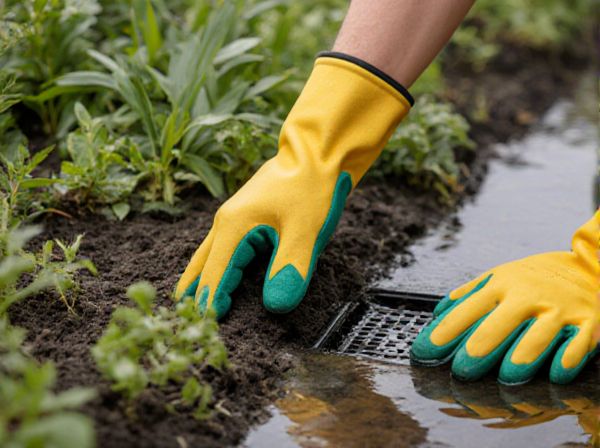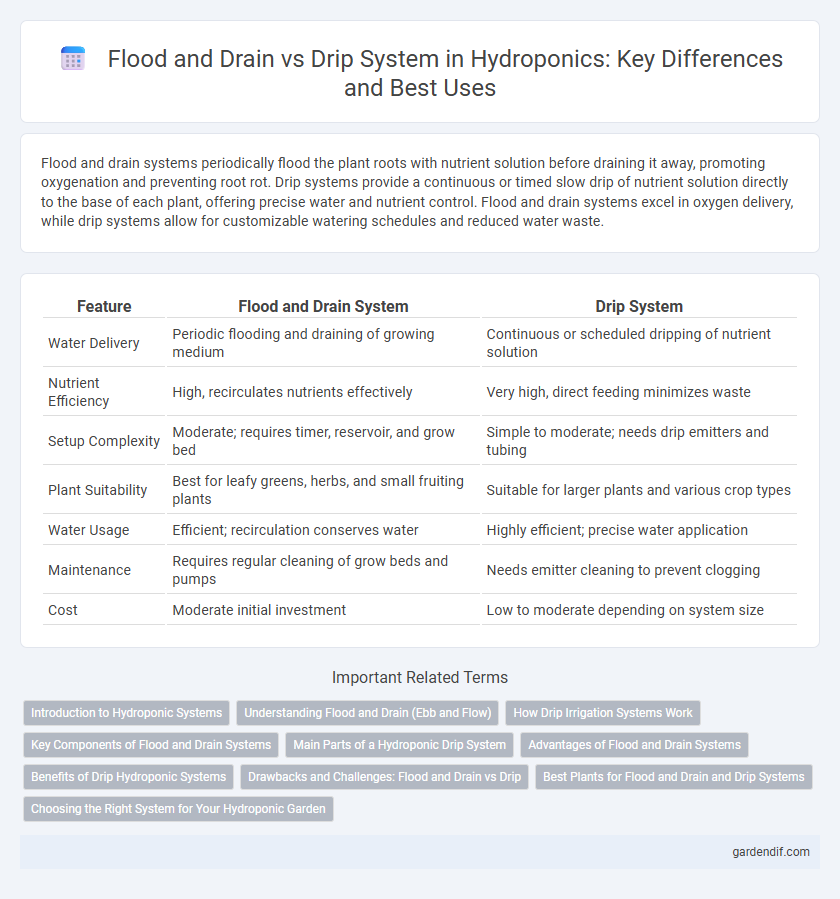
Flood and Drain vs Drip System Illustration
Flood and drain systems periodically flood the plant roots with nutrient solution before draining it away, promoting oxygenation and preventing root rot. Drip systems provide a continuous or timed slow drip of nutrient solution directly to the base of each plant, offering precise water and nutrient control. Flood and drain systems excel in oxygen delivery, while drip systems allow for customizable watering schedules and reduced water waste.
Table of Comparison
| Feature | Flood and Drain System | Drip System |
|---|---|---|
| Water Delivery | Periodic flooding and draining of growing medium | Continuous or scheduled dripping of nutrient solution |
| Nutrient Efficiency | High, recirculates nutrients effectively | Very high, direct feeding minimizes waste |
| Setup Complexity | Moderate; requires timer, reservoir, and grow bed | Simple to moderate; needs drip emitters and tubing |
| Plant Suitability | Best for leafy greens, herbs, and small fruiting plants | Suitable for larger plants and various crop types |
| Water Usage | Efficient; recirculation conserves water | Highly efficient; precise water application |
| Maintenance | Requires regular cleaning of grow beds and pumps | Needs emitter cleaning to prevent clogging |
| Cost | Moderate initial investment | Low to moderate depending on system size |
Introduction to Hydroponic Systems
Flood and drain and drip systems are popular hydroponic methods that optimize nutrient delivery to plants. Flood and drain systems periodically flood the root zone with nutrient solution before draining it away, promoting oxygenation and preventing root rot. Drip systems provide a steady, controlled flow of nutrient solution directly to each plant's roots, maximizing water efficiency and minimizing waste.
Understanding Flood and Drain (Ebb and Flow)
Flood and Drain, also known as Ebb and Flow, is a hydroponic system that temporarily floods the plant roots with nutrient-rich water before draining it back into a reservoir, optimizing oxygen exposure and nutrient absorption. This method supports rapid root growth and reduces the risk of root diseases compared to constant water exposure systems. Flood and Drain systems are ideal for growing leafy greens, herbs, and fruiting crops in controlled environments.
How Drip Irrigation Systems Work
Drip irrigation systems deliver precise amounts of nutrient-rich water directly to the plant roots through a network of tubes and emitters, minimizing water waste and promoting efficient nutrient absorption. This method continuously cycles water, ensuring consistent moisture levels without waterlogging, which is crucial for optimal hydroponic growth. Compared to flood and drain systems, drip irrigation allows for better control over irrigation timing and nutrient delivery, optimizing plant health and yield.
Key Components of Flood and Drain Systems
Flood and drain systems utilize key components such as a growing tray, a nutrient reservoir, a submersible pump, and a timer to periodically flood and drain the plants' root zone, promoting oxygenation and efficient nutrient uptake. The growing tray holds the plants and growing medium, while the nutrient reservoir stores the water and nutrient solution circulated by the pump during flood cycles. Timers control the pump operation to ensure cycling frequency, creating an oxygen-rich environment critical for root health compared to the more continuous delivery of nutrients in drip systems.
Main Parts of a Hydroponic Drip System
A hydroponic drip system primarily consists of a reservoir, a submersible pump, drip emitters, and a network of tubing that delivers nutrient-rich water directly to the plant roots. Unlike flood and drain systems that periodically flood the grow tray, drip systems provide a continuous or scheduled flow, allowing precise control over water and nutrient delivery. This setup minimizes water wastage and promotes healthy root oxygenation, enhancing plant growth efficiency.
Advantages of Flood and Drain Systems
Flood and Drain systems offer superior oxygenation to plant roots by periodically flooding and draining the growing medium, which enhances nutrient uptake and promotes robust root development. These systems are highly versatile and can accommodate a wide variety of crops, making them popular for both commercial growers and hobbyists. Maintenance is simplified due to fewer clogged emitters compared to drip systems, reducing the risk of system failure and ensuring consistent water delivery.
Benefits of Drip Hydroponic Systems
Drip hydroponic systems deliver nutrient-rich water directly to the root zone, promoting efficient water usage and minimizing waste compared to flood and drain setups. Precise control over nutrient delivery in drip systems enhances plant growth and reduces the risk of overwatering or root diseases. Scalability and easy automation make drip systems ideal for commercial hydroponic farms seeking consistent crop yields and resource optimization.
Drawbacks and Challenges: Flood and Drain vs Drip
Flood and Drain systems face challenges like root oxygen deprivation and potential waterlogging, which can stress plants and reduce yield. Drip systems encounter issues with emitter clogging, uneven water distribution, and higher maintenance requirements to ensure consistent nutrient delivery. Both systems demand careful monitoring of water and nutrient levels to prevent plant health problems and ensure optimal growth conditions.
Best Plants for Flood and Drain and Drip Systems
Flood and drain systems excel with leafy greens like lettuce, spinach, and herbs due to their efficient water cycling and oxygenation, promoting rapid root growth. Drip systems are ideal for fruiting plants such as tomatoes, peppers, and strawberries, offering precise nutrient delivery and reducing water waste. Both systems support a range of plants, but matching crop type to system enhances yield and health.
Choosing the Right System for Your Hydroponic Garden
Flood and drain systems cycle nutrient solution to roots by periodically flooding and draining the grow tray, offering efficient oxygenation and nutrient absorption ideal for fast-growing crops like lettuce and herbs. Drip systems deliver nutrient solution directly to each plant through emitters, providing precise water control and suitable for larger plants with higher water needs such as tomatoes and peppers. Selecting the right hydroponic system depends on crop type, desired automation level, water use efficiency, and system scalability to optimize growth and yield.
Flood and Drain vs Drip System Infographic

 gardendif.com
gardendif.com